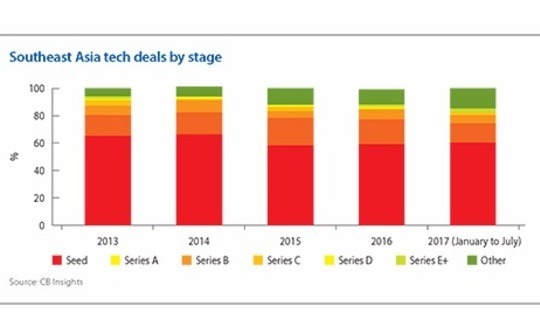
Southeast Asia VC: Growth impediment?
Southeast Asia has an abundance of local players targeting early-stage deals while foreign investors fly in to participate in the later stage rounds. The industry is looking for ways to fill the hole in the middle
Chope, a Singapore-headquartered restaurant booking platform with a presence in Hong Kong, mainland China, Indonesia, and Thailand, was approached by several prospective strategic buyers last year. Negotiations ensued, but then calls started to come in from VC firms, including a number of overseas-based players. Chope abandoned the sale option in favor of a new funding round at a higher valuation.
The Series D round closed last month with S$18.35 million ($13 million) in commitments from eight new and existing investors, led by Australia-based Square Peg Capital. CapitalLand's corporate VC arm C31 Ventures and Moelis Australia Asset Management are among the new entrants, while several local investors like NSI Ventures and DSG Consumer Partners re-upped.
While Chope has proved that growth-stage capital is available in Southeast Asia, Arrif Ziaudeen, the company's founder and CEO, cautions that the journey through the institutional funding rounds is not easy. "Start-ups need to show traction in 2-3 foreign countries, a convincing path to profitability, decent exit prospects, and cast a fairly wide net in search of investors," he says. "The investor we are ultimately working with is headquartered in Australia. The other candidates were not based in Asia Pacific."
Chope's experiences offer a snapshot of the VC fundraising environment in Southeast Asia. The region is awash with early-stage capital providers but there are relatively few local investors capable of providing mid-stage funding. Start-ups must look further afield if they are to sustain their growth – at least until the later stages when regional PE firms, working out of their Singapore offices, start to get interested.
Finian Tan, chairman and founder of Singapore-headquartered Vickers Ventures Partners, likens the market to a barbell. "At one end, money is available from smaller funds. At the other, you have the large private equity players, such as SoftBank's Vision Fund, and strategic players like China's Tencent and Alibaba, writing big checks. In the middle, it's empty. There aren't many players focusing on Series B and C rounds, putting in $5-10 million," he explains.
Planting seeds
Investment in Southeast Asia-based private technology companies through the first seven months of 2017 amounted to $6.4 billion across 286 transactions, more than any full-year total on record. It was in part the result of a few mega-rounds, such as the $2 billion raised by ride-hailing platform Grab in July. In 2016, 3.1 billion was invested across 347 deals, compared to $1.7 billion and 356 transactions the previous year.
Seed and Series A investments have accounted for about 80% of overall deal volume in each of the last four years, while the Series B portion is just 10%. This finding correlates to a study published by Google and Temasek Holdings in May of last year. Of the 681 start-ups in Southeast Asia that received funding between 2010 and 2015, 508 were at the seed stage. Later stage activity was limited, although five start-ups received 65% of all capital committed in 2015.
The high concentration of seed-stage activity is largely driven by numerous government initiatives launched in Singapore and Malaysia in recent years. Following a policy objective to encourage innovation, they have seeded as many start-ups as possible in the hope that some will graduate to later-stage rounds, achieve critical mass, and trigger the kind of virtuous cycle of talent and capital evident in developed technology hubs. But an early byproduct of these efforts is bad ideas getting funded.

The situation has improved compared to five years ago when it was difficult to find Series A funding in the region. Partly due to government support, the likes of Golden Gate Ventures and Monk's Hill Ventures have raised funds of $60-$80 million to fill the pre-A and Series A gap. Meanwhile, NSI raised $89 million for its debut vehicle and Jungle Ventures closed its second fund at $100 million. Both concentrate on Series A and selective Series B investments.
"Like a wave, as more start-ups reach our size, more VC funds are created in the anticipation of further similar opportunities. I see the frontier of this ‘gap' being pushed further out each year, with an increase in what we consider ‘normal' round sizes and valuations," says Chope's Ziaudeen.
Nevertheless, Series B remains the hardest round for Southeast Asian start-ups to raise – the one where an entrepreneur's vision is supposed to crystallize into hard financial numbers that mark out a clear path to success. Jungle, for its part, raises the bar higher, insisting that prospective investees are must not only be revenue-positive but also profitable. This qualification is intended to ensure that a business is strong enough to attract private equity and corporate investors in follow-on rounds.
"Many companies reaching the scale at which they can raise a Series B round will look to get money from non-VC investors. The ecosystem has changed dramatically over the last three years. We have seen high-quality companies quickly receive term sheets from local PE funds and family offices, as well as Chinese internet companies, looking to invest in Series B or C rounds," says Amit Anand, co-founder and managing partner at Jungle.
The other extreme
While these investors are now present in the market, they have yet to become reliable sources of capital. Strategic players are seen as inconsistent, completing a flurry of deals and then disappearing for extended periods.
Chinese internet companies – notably Alibaba Group, Ant Financial, Tencent Holdings, Didi Chuxing, and JD.com – are certainly keen to participate but they generally want to write bigger checks. The same can be said of private equity firms. For example, when KKR and Warburg Pincus backed Indonesian ride-hailing and delivery platform Go-Jek last year it was as part of a $550 million round. Three months ago, Tencent and JD.com backed the same company.
Singapore-based real estate listings portal PropertyGuru has attracted a similar following. The company closed its Series B round at $47 million in 2012 after receiving 11 term sheets from local and international investors. There were nine terms sheets for the Series C three years later. A total of $129 million was raised, led by TPG Capital because PropertyGuru wanted to leverage the GP's regional presences and relationships with local conglomerates. Over the past nine months, the company has been approached by several foreign PE players looking to invest even larger amounts.
"There is not a lack of funding, more a lack of opportunities to invest larger sums in larger-scale companies. In the Southeast Asia tech space, only a very small number of companies have managed to scale in multiple countries and achieve a significant valuation. As a result, there aren't many options for PE guys to deploy as much capital as they would like," says Steve Melhuish, PropertyGuru's founder. "If there is a crunch, it's a crunch of large-scale start-ups."
Indeed, start-ups that have large addressable markets – and have proved they can actually address them – attract plenty of prospective investors. They tend to be dominant players in certain verticals in Indonesia, the region's most populous market, or viable multi-country operators. E-commerce marketplace Tokopedia would fall into the former category and ride-hailing platform Grab in the latter.
Meanwhile, Singapore-based online grocer RedMart is cited as an example of a company that struggled to take its model into new markets and consequently struggled to raise capital on terms it found acceptable. After a Series C round was non-forthcoming, RedMart was sold to Southeast Asian e-commerce platform Lazada, which had recently been acquired by Alibaba.
"Large companies in the region still have access to capital so there is no ‘crunch.' But local and foreign VC firms expect to see more high-quality companies emerge in the region that can raise larger growth-stage rounds. So these managers want to raise larger funds and push into that space," says Justin Nguyen, an operating advisor at Singapore Monk's Hill Ventures.
Recent arrivals include B Capital Group, a VC firm co-founded by Facebook co-founder Eduardo Saverin. B Capital is in the process of raising a US-Asia cross-border fund – with an initial target of $250 million – that is intended to help fill in the gaps in VC ecosystem. The founders identified Series B and C rounds in Southeast Asia as one of the biggest gaps.
Meanwhile, Shanghai-based Gobi Partners is looking to raise $200 million for an ASEAN growth fund that will invest $5-20 million in around 15-20 start-ups at Series B and C stages. The likes of General Atlantic and Sequoia Capital India have also established a foothold in the region and are actively pursuing deals.
Among the local managers, Monk's Hill closed its debut fund at S$100 million ($80 million) in 2015 and is now making plans for a larger successor vehicle that will concentrate on Series A and B investments. Vertex completed fundraising for its latest Southeast Asia and India fund last week with $210 million in commitments. It also targets A and B rounds.
Vickers has a broader geographical spread for its fifth fund, which closed at $230 million, taking in China, India and the US as well as Southeast Asia. However, Tan wants to raise a $400 million Asian impact fund to focus on Southeast Asia growth-stage opportunities. "If you want to raise a $200-$400 million fund, you need to be in the business longer, because institutional investors won't back first- or second-time funds," he says.
Sub-regional solutions
The geographical focus of these larger funds will likely mirror that of the established start-ups they are backing. With Indonesia seen as the only market capable of delivery country-specific unicorns, Southeast Asia is increasingly treated as a single opportunity for companies targeting a handful of urban centers with young populations and similar consumption habits.
Only financial technology and e-commerce businesses require strong localized efforts, observes Dmitry Levit, a partner at Cento Ventures. Other start-ups can freely operate within the region. In response to this, several Singapore-based VC firms, including Vertex, are putting more resources on the ground in other Southeast Asian countries.
"If you have a small fund, there is not much in management fees. As funds get larger – whether they are from Singapore or Indonesia – managers have the resources to push out into the region and have a presence in countries like Vietnam, Thailand, and Malaysia. You are going to see more players executing this strategy over the next few years," says Nguyen of Monk's Hill.
The Temasek-Google study found that the six major ASEAN markets – Indonesia, Malaysia, the Philippines, Singapore, and Thailand – constitute the world's fastest-growing internet region, with the existing user base of 260 million set to reach 480 million by 2020. Similarly, the internet economy is projected to be worth $197 billion by 2025, up from $31 billion in 2015.
Although there is no arguing with the fundamentals, LPs aren't necessarily ready to subscribe to this notion of the expanding venture capital ecosystem. According to industry participants, a number of firms are struggling to get traction with funds intended to address growth-stage opportunities. Investors, it would seem, are reluctant to back larger funds until they have seen more results from the smaller ones.
Southeast Asia needs success stories and it is hoped one will come when Singapore-headquartered mobile internet and gaming platform Sea – formerly known as Garena – lists in the US later this month. The company has a host of big-name backers like Hillhouse Capital, Tencent, and Temasek.
"When Ctrip went public in 2003 on NASDAQ it opened US eyes to China. For Southeast Asia, we need to have more similar moments, although they may not be on that scale," says Eddy Chan, co-founder of Indonesia-focused Intudo Ventures. "Those public market events can open up the fundraising environment, particularly in terms of institutional investors that want exposure to the Southeast Asia VC."
Latest News
Asian GPs slow implementation of ESG policies - survey
Asia-based private equity firms are assigning more dedicated resources to environment, social, and governance (ESG) programmes, but policy changes have slowed in the past 12 months, in part due to concerns raised internally and by LPs, according to a...
Singapore fintech start-up LXA gets $10m seed round
New Enterprise Associates (NEA) has led a USD 10m seed round for Singapore’s LXA, a financial technology start-up launched by a former Asia senior executive at The Blackstone Group.
India's InCred announces $60m round, claims unicorn status
Indian non-bank lender InCred Financial Services said it has received INR 5bn (USD 60m) at a valuation of at least USD 1bn from unnamed investors including “a global private equity fund.”
Insight leads $50m round for Australia's Roller
Insight Partners has led a USD 50m round for Australia’s Roller, a venue management software provider specializing in family fun parks.







